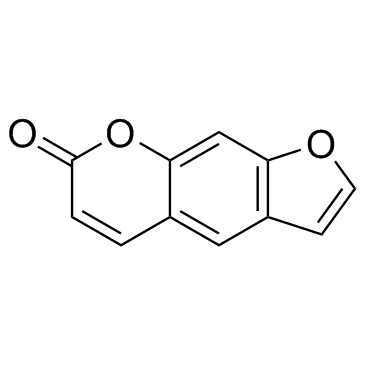
Psoralen
CAS No. 66-97-7
Psoralen( Ficusin | Furocoumarin | NSC 404562 )
Catalog No. M15557 CAS No. 66-97-7
Psoralen is used as photochemical probe in studies of DNA mutation and repair mechanisms. Causes photosensitization in human.
Purity : >98% (HPLC)
 COA
COA
 Datasheet
Datasheet
 HNMR
HNMR
 HPLC
HPLC
 MSDS
MSDS
 Handing Instructions
Handing Instructions
| Size | Price / USD | Stock | Quantity |
| 10MG | 58 | Get Quote |


|
| 25MG | 105 | Get Quote |


|
| 50MG | 182 | Get Quote |


|
| 100MG | Get Quote | Get Quote |


|
| 200MG | Get Quote | Get Quote |


|
| 500MG | Get Quote | Get Quote |


|
| 1G | Get Quote | Get Quote |


|
Biological Information
-
Product NamePsoralen
-
NoteResearch use only, not for human use.
-
Brief DescriptionPsoralen is used as photochemical probe in studies of DNA mutation and repair mechanisms. Causes photosensitization in human.
-
DescriptionPsoralen is used as photochemical probe in studies of DNA mutation and repair mechanisms. Causes photosensitization in human.(In Vitro):Psoralen (10-500 μM; 24-48 hours) inhibits cell viability in a concentration- and time-dependent manner in L02 and HepG2 cells. In L02 cells, Psoralen at 400 μM does not significantly change extracellular LDH levels, and 400 μM or 450 μM psoralen inhibits 50–60% of cell viability.Psoralen (150-450 μM; 24 hours) induces significant S-phase arrest in L02 cells in time- and dose-dependent manners, but it does not exhibits significant change in the cycle distribution of HepG2 cells.(In Vivo):Psoralen (oral gavage; 17.5 mg/kg; 6 weeks) reduces the number of metastatic lesions and the rate of bone metastasis by 20% compared to vehicle-treated mice. It also reduces tumor infiltration and decreases the percentage of tumor cells in metastatic lesions by ~40% compared to vehicle in mice.
-
In VitroCell Proliferation Assay Cell Line:L02 and?HepG2 cells Concentration:10 μM, 50 μM,100 μM, 200 μM, 300 μM,400 μM,450 μM,500 μM Incubation Time:24 or 48 hours Result:Inhibited the viability of L02 and HepG2 cells mainly by suppressing cell proliferation rather than causing cell death. Cell Cycle Analysis Cell Line:L02 and?HepG2 cells Concentration:150 μM; 300 μM; 450 μM Incubation Time:24 or 48 hours Result:Induced cell S-phase arrest instead of causing cell apoptosis or death.
-
In VivoAnimal Model:Female nude (BALB/c nu/nu) mice Dosage:17.5 mg/kg Administration:Oral gavage; 17.5 mg/kg; 6 weeks Result:Inhibited metastasis of breast cancer to bone in vivo.
-
SynonymsFicusin | Furocoumarin | NSC 404562
-
PathwayOthers
-
TargetOther Targets
-
RecptorOthers
-
Research AreaCancer
-
Indication——
Chemical Information
-
CAS Number66-97-7
-
Formula Weight186.17
-
Molecular FormulaC11H6O3
-
Purity>98% (HPLC)
-
SolubilityDMSO: 10 mM
-
SMILESO=C1OC2=CC3=C(C=CO3)C=C2C=C1
-
Chemical Name——
Shipping & Storage Information
-
Storage(-20℃)
-
ShippingWith Ice Pack
-
Stability≥ 2 years
Reference
1. Yang L, Sun X, Geng X. Pak J Pharm Sci. 2015 Mar;28(2 Suppl):667-70.
molnova catalog



related products
-
BQ-3020 TFA (143113-...
BQ-3020 (TFA) is a selective ETB receptor agonist that inhibits [125I] et-1 binding to the ETB receptor in the cerebellum with a 0.2nm IC50, causing vasoconstriction.
-
Triplin
Triplin is a chelator of copper ion. Triplin affects the transport of copper ions from ATX1 to RAN1.
-
Cefodizime Sodium
Cefodizime Sodium is a third generation cephalosporin antibiotic has broad-spectrum activity.



 Cart
Cart
 sales@molnova.com
sales@molnova.com


